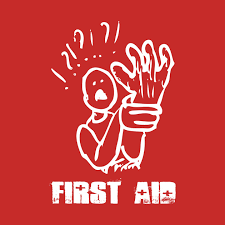
Blood vessels are present throughout the body. Bleeding occurs when tissues are damaged. Heavy bleeding is likely if a major blood vessel is damaged. Bleeding reduces the oxygen-carrying capacity of blood. If heavy or uncontrolled, bleeding can quickly become life threatening.
Arterial bleeding is bright red and will often spurt from a wound. It can be difficult to control due to pressure created by the heart’s contractions.
If the blood is dark red and flowing steadily, it is likely coming from a damaged vein. Bleeding from a vein can be heavy. Regardless of the source, all heavy bleeding must be controlled as soon as possible.
Clot-forming fibers naturally collect at a wound site to create a path to stop bleeding. Severe bleeding can overwhelm this process and prevent clotting from occurring.
Earlier the ABC was associated with CPR which has now become CAB, but now there is new ABC and this time it is associated with bleeding control.
How and Who Can Help:
The greater the number of people who know how to control bleeding in an injured
patient, the greater the chances of surviving that injury. You can help save a life by knowing how to stop bleeding if someone, including yourself, is injured.
 Traumatic injury is one of the leading cause of death for people under 50 years of age. A large potion of those deaths are from severe bleeding – the treatable cause. Up to 20% trauma deaths could be prevented with effective bleeding control.
Traumatic injury is one of the leading cause of death for people under 50 years of age. A large potion of those deaths are from severe bleeding – the treatable cause. Up to 20% trauma deaths could be prevented with effective bleeding control.
PRIMARY PRINCIPLES OF TRAUMA CARE RESPONSE:
■ Ensure you own safety
The ABCs of Bleeding
■ A – Alert – Call EMS (1122 for All Punjab or local EMS in other parts of Pakistan)
■ B – Bleeding – find the bleeding injury
■ C – Compress – apply pressure to stop the bleeding
1. Covering the wound with a clean cloth and applying pressure by pushing directly on it with both hands, OR
2. Using a tourniquet, OR
3. Packing (stuffing) the wound with gauze or a clean cloth and then applying pressure with both hands.
Personal Safety:

REMEMBER, your personal safety is always always the top priority. A general impression is a quick sense of what has occurred, or is occurring, when you first observe an emergency scene. This impression can help guide you in your approach. Emergency scenes are often unsafe. Your personal safety is always the highest priority, even before the safety of an ill or injured person. Always pause for a moment before approaching an emergency and look for obvious hazards. Consider the possibility of hidden dangers.
■ If you become injured, you will not be able to help the victim.
■ Provide care to the injured person if the scene is safe for you to do so.
■ If, at any time, your safety is threatened, attempt to remove yourself (and the victim if possible) from danger and find a safe location.
■ Protect yourself from blood-borne infections by wearing gloves and other valid barriers, if available, and if not then improvise but don’t compromise your personal safety.




The only thing more tragic than a death from bleeding…
IS A DEATH THAT COULD HAVE BEEN PREVENTED.
So get trained and make the difference between life and death. Mark your calendar today for our next training session:
Karachi: July 07, 2018 Advanced Bleeding Control Techniques
Lahore: July 15, 2018 Advanced Bleeding Control Techniques
Islamabad: July 29, 2018 Advanced Bleeding Control Techniques
For Your Safety,
Faisal Javed Mir & First Aid to Save a Life Pakistan
Did you like the post? Let’s get connected on Facebook, LinkedIn, Twitter & YouTube.
You might also like:
MEDIC First Aid International – Instructor Development Course
MEDIC First Aid USA
First Aid for Small Businesses
First Aid for Family
Upcoming Training Courses



 Twitter Profile
Twitter Profile Flickr Profile
Flickr Profile YouTube Channel
YouTube Channel Linkedin Profile
Linkedin Profile Facebook Profile
Facebook Profile
